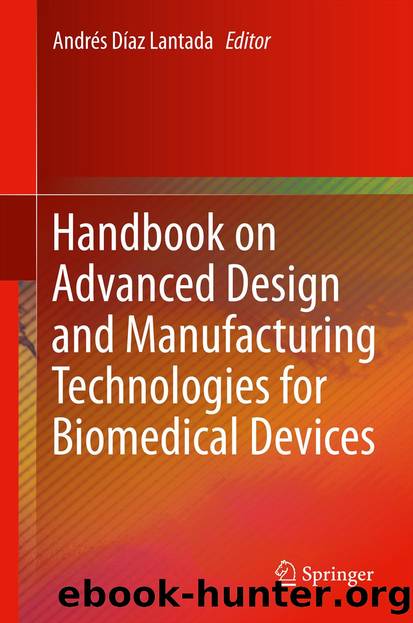Handbook on Advanced Design and Manufacturing Technologies for Biomedical Devices by Andrés Díaz Lantada

Author:Andrés Díaz Lantada
Language: eng
Format: epub
Publisher: Springer US, Boston, MA
10.2 Overview of Additive Manufacturing Processes with Impact on the Biomedical Field
The various technologies available can operate and manufacture prototypes using a wide range of metals, ceramics, or polymers, both with synthetic and biological origin and with outstanding precision (see scheme of Fig. 10.2).
Fig. 10.2Overview of remarkable additive manufacturing technologies and of the materials they use for building the prototypes
Remarkable technologies (and associated materials) with a significant impact on the evolution of the rapid prototyping industry include laser stereolithography (photosensitive polymers), selective laser sintering (polymer powder, usually nylon, or ceramic powder), 3D printing (powder with binder, liquid resins), fused deposition modelling (thermoplastics), digital light processing (photopolymers, bio-photopolymers), or direct laser writing (photopolymers, ceramics, ormocere, biomaterials), these last two very linked to the manufacture of micrometric objects (see Chap. 12).
There are other more recent technologies with an optimized precision of a few micrometers or even hundreds of nanometers also capable of using materials for specific applications in biomedical engineering, such as obtaining implantable devices or manufacturing scaffolds for tissue engineering processes, as will be discussed in forthcoming sections.
Certain “rapid tooling” technologies within rapid manufacturing are also noteworthy, as they can produce tools and parts for injection molds quickly and economically, either by reproducing the geometry of physical models, through shape-copying processes (copying the geometries from rapid prototypes), or by directly manufacturing such tools and parts in an additive way. These “rapid tooling technologies” and “rapid form-/shape-copying processes” are described in more detail in Chap. 11, although Fig. 10.3 includes a brief schematic description of the different connections between rapid prototyping and rapid tooling, thus covering main processes in the field of rapid manufacturing.
Fig. 10.3Scheme of different rapid manufacturing technologies (Adapted from H. Lorenzo and P. Lafont, Product Development Laboratory, Universidad Politécnica de Madrid)
Download
This site does not store any files on its server. We only index and link to content provided by other sites. Please contact the content providers to delete copyright contents if any and email us, we'll remove relevant links or contents immediately.
| Automotive | Engineering |
| Transportation |
Whiskies Galore by Ian Buxton(41528)
Introduction to Aircraft Design (Cambridge Aerospace Series) by John P. Fielding(32888)
Small Unmanned Fixed-wing Aircraft Design by Andrew J. Keane Andras Sobester James P. Scanlan & András Sóbester & James P. Scanlan(32573)
Craft Beer for the Homebrewer by Michael Agnew(17932)
Turbulence by E. J. Noyes(7700)
The Complete Stick Figure Physics Tutorials by Allen Sarah(7137)
Kaplan MCAT General Chemistry Review by Kaplan(6595)
The Thirst by Nesbo Jo(6435)
Bad Blood by John Carreyrou(6274)
Modelling of Convective Heat and Mass Transfer in Rotating Flows by Igor V. Shevchuk(6222)
Learning SQL by Alan Beaulieu(6035)
Weapons of Math Destruction by Cathy O'Neil(5827)
Man-made Catastrophes and Risk Information Concealment by Dmitry Chernov & Didier Sornette(5645)
Digital Minimalism by Cal Newport;(5389)
Life 3.0: Being Human in the Age of Artificial Intelligence by Tegmark Max(5184)
iGen by Jean M. Twenge(5161)
Secrets of Antigravity Propulsion: Tesla, UFOs, and Classified Aerospace Technology by Ph.D. Paul A. Laviolette(4988)
Design of Trajectory Optimization Approach for Space Maneuver Vehicle Skip Entry Problems by Runqi Chai & Al Savvaris & Antonios Tsourdos & Senchun Chai(4839)
Electronic Devices & Circuits by Jacob Millman & Christos C. Halkias(4746)
